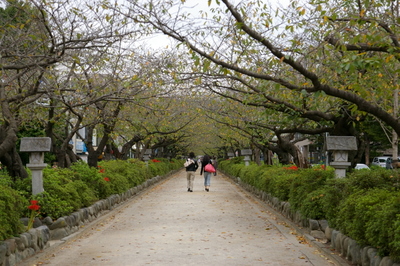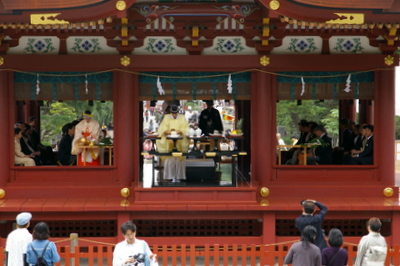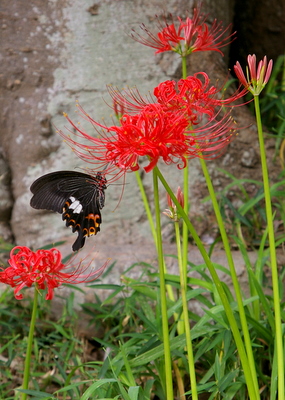 Kamakura is known for its numerous temples and shrines, and on the recommendation of our hosts, we went to check it out. It’s about an hour’s train ride from Tokyo on a commuter train. The trip is pleasant and we watched the change in scenery along with the (sometimes crazy) footwear of the other passengers.  Boots are big here, as are knee-high socks with heels (reflecting the appearance of boots), and overall I feel that Japanese have a really fun sense of fashion.  In Tokyo there’s sophisticated dressers (but not boring), and of course there is the more statement-oriented dressers sporting bright colored shoes, crazy layers of clothes, etc. Anyways, since I tend to look towards the floor when on commuter trains (to avoid awkward eye contact) this makes for some fun shoe-watching.
Kamakura is known for its numerous temples and shrines, and on the recommendation of our hosts, we went to check it out. It’s about an hour’s train ride from Tokyo on a commuter train. The trip is pleasant and we watched the change in scenery along with the (sometimes crazy) footwear of the other passengers.  Boots are big here, as are knee-high socks with heels (reflecting the appearance of boots), and overall I feel that Japanese have a really fun sense of fashion.  In Tokyo there’s sophisticated dressers (but not boring), and of course there is the more statement-oriented dressers sporting bright colored shoes, crazy layers of clothes, etc. Anyways, since I tend to look towards the floor when on commuter trains (to avoid awkward eye contact) this makes for some fun shoe-watching.
           When we arrived at the Kamakura station we were delighted to find an assortment of informational sheets on various sites and walking routes in the city. I was impressed with the quality and usefulness of the information included on these small sheets. Each one had a map, history, transportation time and options (including bus route numbers), hours of operation and admission fee (if applicable). I’ve picked up a lot of maps and tourist pamphlets over the past year, and these may have been the best of them all. This method is way more convenient than the usual map or city booklets which usually contain a lot of information you don’t need. Matt and I chose a few leaflets with walking routes and a couple with information on the places we planned to visit. And off we went.
           Kamakura is a touristy town, but not in a bad way. Unlike some places, there are actually a lot of things to see here and getting around is easily done by foot or bus, and the crowds weren’t bad at all. We started by walking down Wakamiya-Oji, the main street through town from the train station towards the Tsurugaoka Hachimangu Shrine. Small shops lined the road selling everything from fresh manju to all kinds of pickles and the standard souvenirs to more unique items, like hand-dyed textiles. In the middle of the road was a long, tree-lined promenade leading all the way to the shrine. After a year with no seasons except summer, it finally felt like autumn.Â

The promenade continued from the entrance up to the shrine, flanked on either side by ponds bursting with water lilies, buildings, including a small museum, and a few vendors selling snacks and artwork. Closer to the shrine many artists sat sketching and painting the scene from the hill in front of them. At the base of the hill was a large pavilion. A Shinto wedding ceremony was taking place and the participants seemed to be stoically oblivious (or perhaps just indifferent) to the dozens of people passing by, many of whom were taking pictures.Â


           An inviting staircase led up the hill to the main building. A happy flock of trees graced the hillside, and cheerfully covered the area around the shrine. We walked up the stairs, enjoying the bevy of activity happening around us. Many people were buying Ema, small wooden plaques on which to write prayers and wishes. The Ema are hung in front of the shrine so that the Kami (gods) can read them. We saw many families with small babies dressed in what looked like christening clothes. Apparently there is a similar type Shinto ceremony for blessing new babies. The Tsurugaoka Hachimangu Shrine was an enjoyable place to visit because it had such a welcoming atmosphere, accommodating those visiting for whatever reason, even just curious tourists like us.
           We left the shrine by way of another path that took us past another temple tucked back in the woods. It was beautifully framed by the forest, and as we walked away the trees slowly closed in around it. Following the path, we exited the Tsurugaoka Hachimangu area and walked down a side street towards our next destination: Hokokuji Temple. We had no big plans for our day in Kamakura, so we took our time walking. On the way we spent a few minutes watching a butterfly flutter amidst a cluster of flowers. The butterfly was so big that every time the wings closed it dipped for a second before the next flap. And so it zigzagged horizontally through the big blooms until finding a satisfactory spot to sip some nectar. The delicate red petals provided a nice compliment to the curves of the butterfly’s solid black wings. More fauna was to be enjoyed in the steam that ran alongside the road: wild carp. They looked ancient, and their thick bodies looked toughened to the harsher environment of this stream as compared to the usual garden ponds I’ve seen such fish in. We watched them swim for awhile and it seemed that they were watching us back.

           Hokokuji Temple was, not surprisingly, very beautiful and peaceful. We spent some time walking around the grounds and enjoyed the bamboo garden in the back. These bamboos are Moso, the biggest species of the plant, and they looked so elegant with their clean, strong lines. Presently, Matt and I both started to feel our tummies grumble, so we headed off back towards the main part of town to find some food. Our search consisted of examining the obligatory bowls of plastic food in window displays outside of each restaurant. I’m not sure how this is a good judge of a restaurant since I’m sure all the plastic cuisine must come from the same place, but at least we knew what was available to order. We chose a friendly little spot and ordered a couple bowls of soba noodles, which happily came with little mocha balls on the side. The simple but tasty meal fit the feel of the town.
           It was a mellow day for us, and also our last full day in Japan. The afternoon in Kamakura sped by and before we knew it we had to catch the train back into the city to meet the Tosu’s for dinner. There was still so much more to see, but it didn’t feel as though our day-trip had lacked anything. I like places like that—where there is enough to keep you engaged without having to do everything. There we still over a dozen temples we had yet to see, Yuigahama Beach, and probably dozens of tasty restaurants and snacks to sample along the way. The best way I can think of to describe the feeling is that it’s like Thanksgiving, where you know there will be more to eat later (turkey sandwiches and pumpkin pie for breakfast). You had a great meal and good company, but it’s just the beginning of the holiday season.Â
 Tonight was more Tokyo highlife. Literally, as the Tosu’s took us to observation deck of the Roppongi Hills Mori Tower. It is the highlight of the new Roppongi Hills district. The observation deck was really cool with windows all the way around the 52nd floor, offering 360 degrees of great views. We went at sunset and watched the city darken and then illuminate. Akio and Yusuke checked out the Sky Aquarium, while the rest of us looked at a contemporary art museum on the 53rd floor. The city views were the highlight though.
Tonight was more Tokyo highlife. Literally, as the Tosu’s took us to observation deck of the Roppongi Hills Mori Tower. It is the highlight of the new Roppongi Hills district. The observation deck was really cool with windows all the way around the 52nd floor, offering 360 degrees of great views. We went at sunset and watched the city darken and then illuminate. Akio and Yusuke checked out the Sky Aquarium, while the rest of us looked at a contemporary art museum on the 53rd floor. The city views were the highlight though.
